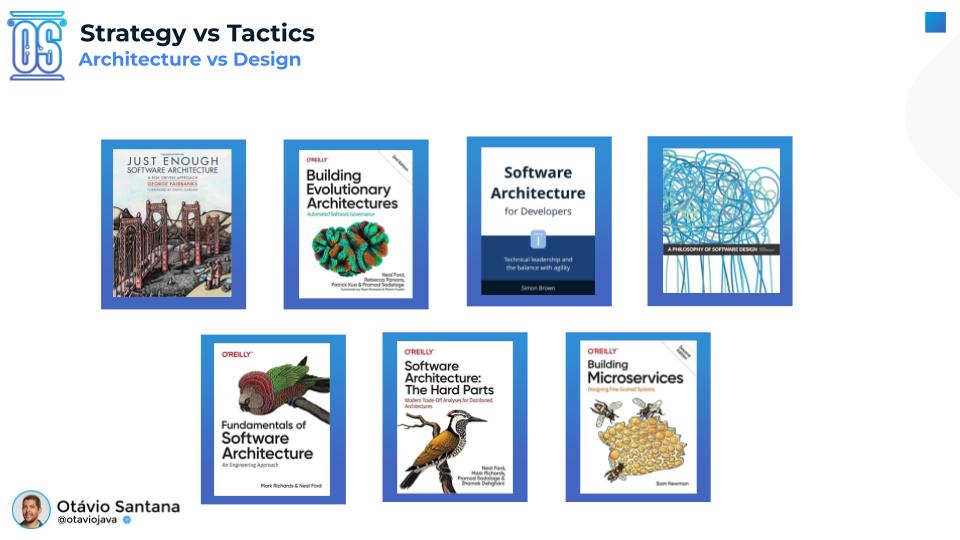Differences Between Software Design and Software Architecture
Explore the key differences between software architecture (the strategic "why") and design (the tactical "how") with insights from influential industry books.
Join the DZone community and get the full member experience.
Join For FreeWhen discussing software design and software architecture, the first question that often arises is: What do these terms mean? Despite their importance in software development, they usually need to be understood, with definitions that vary widely depending on the source. This lack of consensus can make drawing clear lines between them challenging.
To clarify these concepts, let's explore their distinctions and interconnections, drawing from some of the most influential books in the field:
- Just Enough Software Architecture by George H. Fairbanks
- Building Evolutionary Architectures by Neal Ford, Rebecca Parsons, and Patrick Kua
- Software Architecture for Developers by Simon Brown
- Philosophy of Software Design by John Ousterhout
- Software Architecture: The Hard Parts by Neal Ford and Mark Richards
- Building Microservices by Sam Newman
- Fundamentals of Software Architecture by Mark Richards and Neal Ford

Architecture vs. Design
These books provide a wealth of insights but also present diverse perspectives. These references and your experiences as a developer or architect will shape your understanding of design and architecture. I encourage readers to explore multiple sources, form their definitions, and continuously refine their knowledge.
Across these references, several recurring themes and definitions emerge. Let's break them down.
Software Architecture
- High-level Perspective: Architecture focuses on the big picture, integrating components, services, and systems into a cohesive strategy.
- Strategic: It deals with decisions that are hard to change because of their widespread impact. These decisions often involve trade-offs shaped by the context—team size, business goals, and technology constraints.
- "Why" over "How": As emphasized in Fundamentals of Software Architecture, architecture is as much about the reason behind decisions as it is about the decisions themselves.
For example, adopting a monolithic or microservices architecture isn't inherently right or wrong—it depends on the organization's context. The "right" choice is determined by the trade-offs and the strategy that aligns with business and technical goals.
Software Design
- Tactical Focus: Design operates at a lower level, closer to the code, addressing the day-to-day decisions developers face.
- "How" over "Why": Design is more concerned with the specific ways to solve coding problems.
- Guided by Patterns: Unlike architecture, design often has clearer guidelines for "right" and "wrong." For example, excessive if statements in code are universally seen as a code smell. A solution might involve applying the Strategy Design Pattern to simplify decision logic.
A practical example of design would be implementing a connection pool in Java to manage database connections efficiently, ensuring that resource use is optimized at runtime.
Interplay Between Design and Architecture
One of my favorite perspectives comes from First Principles of Software Architecture, which presents architecture and design as a spectrum. Decisions in one domain inevitably influence the other.
- Architecture Influences Design:
- Choosing a microservices architecture will directly impact design decisions. For instance, the inability to perform a rollback across multiple services necessitates patterns like Saga for managing distributed transactions.
- Design Influences Architecture:
- Applying Domain-Driven Design (DDD), with its tactical patterns like entities, aggregates, and bounded contexts, shapes the architecture by defining layers and enforcing domain boundaries.
This interplay highlights the inseparability of design and architecture. Strategic decisions ripple into tactical implementations, and tactical patterns can reshape the strategic approach.

Practical Recommendations
As with Domain-Driven Design (DDD), start with the strategic (architecture) before moving to the tactical (design). This approach ensures that your software solutions align with broader organizational goals while maintaining the flexibility needed to adapt to change.
Books like The Philosophy of Software Design encourage engineers to view their craft extending beyond the code. This mindset can lead to better integration between architectural and design considerations, ultimately producing software that balances simplicity, scalability, and maintainability.
Closing Thoughts
The goal of this article isn't to settle on a universal definition of software design or architecture — such a definition doesn't exist. Instead, it provides a lens through which you can understand their differences and connections. Combining insights from leading authors with your practical experiences allows you to develop your nuanced understanding of these foundational concepts.
The next time you tackle a complex project, remember:
- Architecture asks why
- Design answers how
- And both work together to turn ideas into reality
Opinions expressed by DZone contributors are their own.

Comments